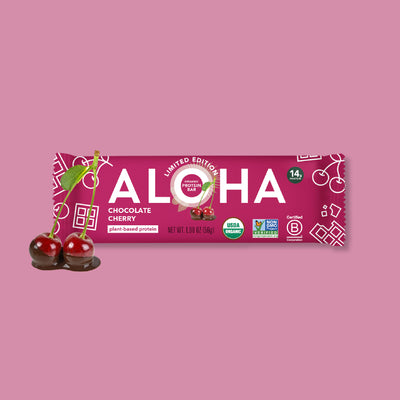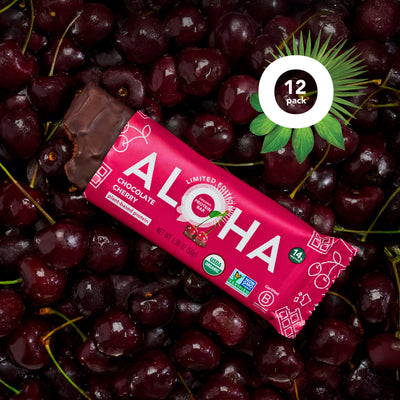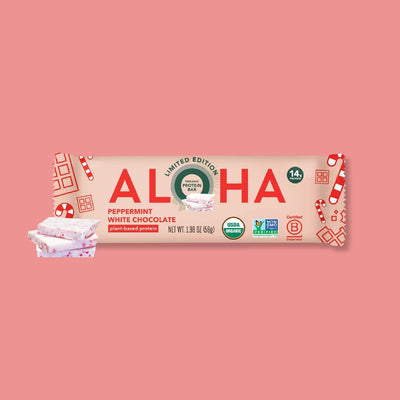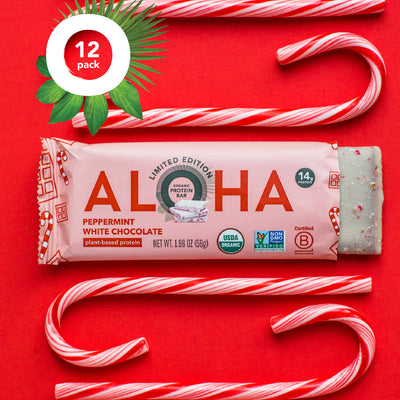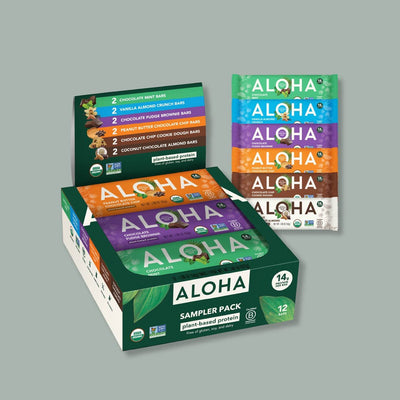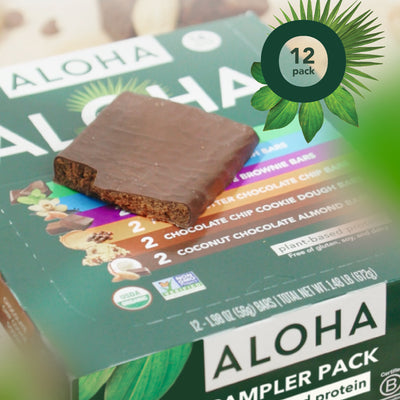Key Takeaways:
-
Protein-First, Flavor-Forward: A simple plate builder makes low calorie high protein meals fast and delicious.
-
Smart Swaps, Big Impact: Lean plant proteins and bold sauces create high protein low calorie meals you’ll actually crave.
-
Built For Real Life: Batch once, mix-and-match all week, hello easy low calorie high protein meals.
If your goal is steady energy and satisfying plates, without a calorie spiral, you’re in the right place. At ALOHA, we craft soy-free, USDA Organic, Non-GMO Project Verified, Certified Vegan proteins that help you assemble low calorie high protein meals in minutes. As an employee-owned Certified B Corp and PBC, we also keep sourcing and community impact front-and-center so your routine supports people and planet.
Why Low-Calorie + High-Protein Works
Protein helps meals feel fuller with fewer calories by pairing satiating amino acids with fiber-rich plants and smart fats. The sweet spot for many adults is distributing protein across the day, not loading it all at dinner. For a quick refresher on why distribution matters (and how much you may need), see all about protein.
The Plate Builder For High Protein Low Calorie Meals
Start with 20–35g protein from legumes, tofu/tempeh, edamame, high-protein grains, or a scoop of soy-free powder. Add a modest portion of smart carbs (quinoa, brown rice, legume pasta, potatoes) and at least half a plate of colorful vegetables. Finish with light, high-impact fats, tahini drizzle, toasted seeds, or olive oil—and a bright sauce (lemon-tahini, chimichurri, salsa verde). This simple structure turns ideas into easy low calorie high protein meals any night.
Pantry & Prep: Your Shortcut To Easy Wins
Keep canned beans and lentils, quick-cook grains, tortillas, frozen veggies, citrus, fresh herbs, and a jar of tahini. Batch two trays on Sunday, spiced chickpeas and crispy tofu, and whisk two sauces. With these anchors, low calorie high protein meals become assemble-and-serve.
Flavor First, Calories Low
Build low calorie high protein meals that pop with bright, calorie-light boosters. Lean on acids (lemon, lime, vinegar), fresh herbs, garlic, ginger, and spice blends to add depth without leaning on heavy oils or cheese. Roast or air-fry proteins like tofu and chickpeas for crispy edges, then finish with a light drizzle of lemon-tahini, salsa verde, or chimichurri so a little goes a long way. Umami lifters—tomato paste, smoked paprika, nutritional yeast, or a splash of soy-free tamari—make high protein low calorie meals feel restaurant-level while keeping portions satisfying and macros on target.
Dining Out And Takeout: Stay On Track
You don’t have to skip dinner plans to keep momentum with easy low calorie high protein meals. Choose grilled, baked, or steamed options; ask for sauces on the side; and double up on vegetables in place of extra starch. Build bowls with beans or tofu, a half-portion of grains, and lots of greens, then add a bright squeeze of citrus at the table. If you’re still hungry, pair your entrée with a simple side salad or broth-based soup—high-volume, low-calorie add-ons that help you leave feeling full, not overstuffed.
14 Low Calorie High Protein Meals (Fast, Flexible, Satisfying)
These ideas are built for real life, minimal prep, big flavor, and plenty of room to remix. Treat each recipe as a template: swap vegetables based on what’s in the crisper, change the base (quinoa, cauliflower rice, tortillas, or potatoes), and finish with a bright sauce like lemon-tahini or chimichurri.
Protein-first building blocks, beans, lentils, tofu/tempeh, edamame, and high-protein grains, keep low calorie high protein meals in the satisfying 20–35g range without excess calories. Leftovers pack perfectly for tomorrow’s lunch, turning effort into momentum. Use this lineup to keep high protein low calorie meals fresh all week, and to make easy low calorie high protein meals your go-to on the busiest night.
Lemon-Tahini Chickpea Bowls
Chickpeas over cauliflower “rice” with cucumbers, tomatoes, herbs, and a light tahini drizzle. Add a squeeze of lemon and a sprinkle of hemp seeds to boost protein and brightness without many calories. Prep the cauliflower rice and chopped veg in advance to assemble in under 5 minutes.
Tempeh Taco Lettuce Wraps
Crumble tempeh with taco spices; spoon into crisp lettuce cups with pico and avocado. Use romaine hearts or butter lettuce for sturdy “shells” and finish with lime for zing. For extra crunch without extra calories, add quick pickled onions or radish slices.
Sheet-Pan Harissa Veg + Tofu
Roast peppers, carrots, and tofu with harissa; finish with lemon and mint. It’s mostly hands-off and scales easily for meal prep. Swap harissa for smoked paprika if you want milder heat while keeping the calories low.
Zucchini Noodle “Alfredo”
Blend silken tofu, garlic, lemon, and nooch for a light sauce; toss with zoodles and peas. The silken tofu delivers creaminess plus protein without heavy fats. Top with black pepper and parsley for a classic finish.
Red Lentil Tomato Soup
Simmer lentils with tomatoes, garlic, and paprika; serve with herb yogurt-style swirl (dairy-free). This cooks fast and thickens naturally, so no cream needed. Add spinach at the end for extra volume and micronutrients at minimal calories.
Sushi-Style Edamame Bowls
Rice or cauliflower rice with edamame, cucumber, nori, and ginger-miso dressing. Keep the dressing light and punchy so a little goes a long way. Sprinkle sesame seeds for texture and a modest protein bump.
Chimichurri Tofu Over Greens
Crispy tofu on a big salad with chimichurri and crunchy seeds. The bold herb sauce means you can use less oil while keeping flavor high. Rotate greens—romaine, arugula, or shredded cabbage—to stay interested all week.
Smoky Bean & Veg Skillet
Black beans, mushrooms, and spinach with smoked paprika; scoop into warm corn tortillas. Mushrooms add meaty texture for very few calories, while beans bring the protein. Finish with lime and cilantro to keep it bright.
Pesto Farro Light
Stir a spoon of pesto through farro, fold in cherry tomatoes and steamed broccoli; top with hemp seeds. Use a lighter pesto (more herbs, less oil) to keep calories in check. Farro’s chewiness makes smaller portions feel satisfying.
Cauliflower Steak “Parmesan”
Bake breaded cauli steaks; top with marinara and nutritional yeast; serve with garlicky greens. Air-frying works well here for extra crisp with minimal oil. A sprinkle of red pepper flakes gives heat without adding calories.
Greek-Style White Bean Pitas
Lemony white beans, tomatoes, cukes, olives—stuff into mini pitas with herbs. Choose whole-wheat mini pitas for portion control and fiber. Add a quick dill-garlic yogurt-style sauce (dairy-free) for tang.
Coconut-Lime Veg Curry
Light coconut milk, tofu, snap peas; serve over steamed cabbage or a half-portion of rice. The cabbage base slashes calories while keeping volume high. Finish with fresh basil or cilantro for freshness.
Chili-Spiced Sweet Potato Boats
Roasted halves stuffed with black beans and corn; finish with lime and scallions. Use smaller sweet potatoes to keep portions moderate and protein forward. A drizzle of salsa adds moisture and flavor for minimal calories.
Mushroom-Walnut Lettuce Cups
Quick sauté with tamari and garlic; spoon into butter lettuce with pickled onions. A small amount of finely chopped walnuts adds richness and texture without many calories when used sparingly. Serve with cucumber slices for extra crunch.
Want day-long strategies to increase protein without extra calories? Here’s how to get more protein with simple pantry moves.
Snack Smarter: Bars, Shakes, And Timing
On hectic days, snacks keep your main meals lighter without hunger rebound. If bars are your go-to, this guide clarifies how many protein bars a day so you can plan portion-wise. Training around meals? Here’s a quick read on should I eat a protein bar before or after a workout to match fuel to your schedule.
Plant-Forward Without The Guesswork
Leaning plant-based makes it easier to keep calories in check while maximizing fiber and micronutrients. If you’re new, this primer, what is a plant-based diet—shows how to start with one plate a day and build momentum from there.
Final Thoughts
With a protein-first blueprint, bold sauces, and a few batch-prepped staples, low calorie high protein meals become second nature. Keep ALOHA’s soy-free powders and ready-to-drink options on hand, rotate a handful of favorites, and enjoy high protein low calorie meals that taste great and fit your goals, no guilt required.
Read Also:
- Clean Protein Power 101: All Your Questions Answered
- Fresh Protein Bars Explained: ALOHA’s Secrets Revealed
- Is Whey A Complete Protein? Your Burning Questions Answered
Frequently Asked Questions About Low Calorie High Protein Meals
How do I know how much protein I need per meal?
Most people feel great aiming for roughly 20–35 grams per meal, adjusted for size, activity, and hunger. Distributing protein across the day tends to support energy and satiety better than a single large serving. For a clear overview of totals and timing, read the “all about protein” article referenced above. Use the plate builder to make that range automatic.
What are the fastest easy low calorie high protein meals?
Sheet-pan tofu and veggies, lentil soups, tempeh lettuce wraps, and chickpea bowls can all land in 20–30 minutes. Keep two sauces ready to change the vibe instantly and use frozen vegetables for speed without sacrificing nutrition. Batch a cooked grain and a tray of crispy tofu on Sunday to remove most of the weekday work. Assembly beats elaborate recipes on busy nights.
Can I hit my goals without soy?
Absolutely. Beans, lentils, quinoa, hemp, pumpkin seeds, and soy-free powders make high protein low calorie meals easy. Mix two protein sources on the plate to reach your target comfortably. The key is consistency and portion awareness.
How do I keep calories low but meals satisfying?
Build volume with non-starchy vegetables and choose lean protein sources, then add small amounts of flavorful fats. Sauces like lemon-tahini or chimichurri deliver big impact with modest calories when used thoughtfully. Balance texture—crunchy seeds, crisp veg, creamy sauces—so every bite feels abundant.
Are protein bars okay if I’m watching calories?
They can be, especially when they replace less filling snacks. Check calories, protein, fiber, and sugar alcohols so the bar fits your plan. For guidance on frequency, see the article about how many protein bars a day, and use bars as strategic tools rather than default meals.
Should I have a protein bar before or after my workout?
It depends on timing and tolerance. A small, protein-forward snack before training can curb hunger, while post-workout protein supports recovery, choose what fits your schedule and digestion. The linked guide on whether to eat a protein bar before or after a workout offers simple rules of thumb. Hydration and total daily intake still matter most.
Do I need to count calories to make this work?
Not necessarily. Using the plate builder, prioritizing vegetables, and choosing lean proteins often gets you close without meticulous tracking. If you stall, a short audit of portions and condiments can reveal easy tweaks. Make small changes you can keep rather than strict rules you’ll abandon.
What if I’m hungry between meals?
Plan protein-forward snacks like edamame, roasted chickpeas, fruit with nuts, or a ready-to-drink protein. Small, strategic bites prevent overeating later and keep energy steady. Aim for options that deliver protein and fiber together for the best staying power.
Can plant-based meals support weight management effectively?
Yes. Plant-forward plates combine protein with fiber and water-rich foods, creating satisfying volume for fewer calories. If you’re exploring a broader shift, the primer on what is a plant-based diet helps you build momentum one meal at a time. Taste and convenience should lead—habits follow when food is craveable.
How do I scale meals for family or meal prep?
Cook components, not just recipes: a tray of tofu, a pot of grains, roasted veggies, and two sauces. Store separately so textures stay great, then assemble bowls, wraps, or salads in minutes. This approach turns easy low calorie high protein meals into a repeatable system for any household size.





